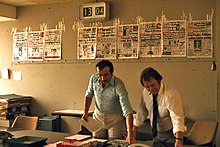
Back تحرير Arabic সম্পাদনা Assamese সম্পাদনা Bengali/Bangla སྒྲིག་མཁན། Tibetan Editace Czech Golygu Welsh Επεξεργασία Greek Edición (proceso) Spanish ویراستاری Persian עריכה HE

Editing is the process of selecting and preparing written, visual, audible, or cinematic material used by a person or an entity to convey a message or information. The editing process can involve correction, condensation, organization, and many other modifications performed with an intention of producing a correct, consistent, accurate and complete piece of work.[1]
The editing process often begins with the author's idea for the work itself, continuing as a collaboration between the author and the editor as the work is created. Editing can involve creative skills, human relations and a precise set of methods.[2][3] Practicing editing can be a way to reduce language error in future literature works.[4]

There are various editorial positions in publishing. Typically, one finds editorial assistants reporting to the senior-level editorial staff and directors who report to senior executive editors. Senior executive editors are responsible for developing a product for its final release. The smaller the publication, the more these roles overlap.
The top editor at many publications may be known as the chief editor, executive editor, or simply the editor. A frequent and highly regarded contributor to a magazine may acquire the title of editor-at-large or contributing editor. Mid-level newspaper editors often manage or help to manage sections, such as business, sports and features. In U.S. newspapers, the level below the top editor is usually the managing editor.
In the book publishing industry, editors may organize anthologies and other compilations, produce definitive editions of a classic author's works (scholarly editor), and organize and manage contributions to a multi-author book (symposium editor or volume editor). Obtaining manuscripts or recruiting authors is the role of an acquisitions editor or a commissioning editor in a publishing house.[5] Finding marketable ideas and presenting them to appropriate authors are the responsibilities of a sponsoring editor.
Copy editors correct spelling, grammar and align writings to house style. Changes to the publishing industry since the 1980s have resulted in nearly all copy editing of book manuscripts being outsourced to freelance copy editors.[5]
At newspapers and wire services, press or copy editors write headlines and work on more substantive issues, such as ensuring accuracy, fairness, and taste. In some positions, they design pages and select news stories for inclusion. At British and Australian newspapers, the term is sub-editor. They may choose the layout of the publication and communicate with the printer. These editors may have the title of layout or design editor or (more so in the past) makeup editor.
In film editing, many techniques are available for use, however, using one doesn't make your edit 'better' than if it were not to be used.[6]
- ^ Mamishev, Alexander, Williams, Sean, Technical Writing for Teams: The STREAM Tools Handbook, Institute of Electrical and Electronics Engineers, John Wiley & Sons. Inc., Hoboken, 2009, p. 128.
- ^ "Encarta Dictionary definition of "editing"". Archived from the original on 22 October 2009.
- ^ "Encarta Dictionary definition of 'editor'". Archived from the original on 6 February 2009.
- ^ Diab, N. M. (2010). Effects of peer-versus self-editing on students’ revision of language errors in revised drafts. System, 38(1), 85-95.
- ^ a b Poland, Louise, The business, Craft and Profession of the Book Editor, in Carter, David, Galligan, Anne, (eds.), Making books: contemporary Australian publishing, Queensland University Press, 2007, p. 100.
- ^ Orpen, Valerie (2003). Film Editing: The Art of the Expressive. Wallflower Press. ISBN 978-1-903364-53-6.